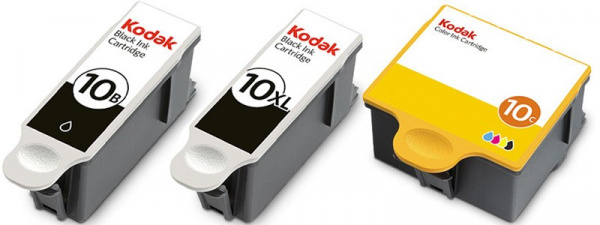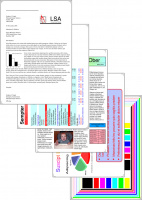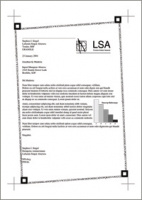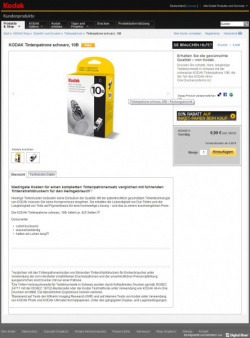Kodak Disguising costs, unfair comparsions, and confusing yields: Triple-cheat by Kodak (Update)
[mark {[fett Update as of July 2nd, 2010:}]] Kodak comments on our article here.
Until recently there were only two types of ink cartridges for Kodak-MFPs on the market: A color combination cartridge and a cartridge for black. In January 2010 Kodak presented new cartridges to replace the ones mentioned above. They fit in all old and new Kodak-MFPs.
The color cartridge Nr. 10C has ten percent more yield than the previous one. The new black cartridge Nr. 10XL is supposed to have 70 percent more yield than the new 10B-cartridge, says Kodak.
Cheat number I: Sham package
Not until half a year after first presentation of these cartridges, in the beginning of June, our lab got a description of yield according to ISO-24711/12 for the black ink cartridge 10B. At once we noticed it has less yield than its predecessor. Yield of the 10XL cartridge Kodak has not published yet.
But even with the 10XL, cost per page will not become less than with the 10B (which already costs 20 percent more than its predecessor), the price increase of the 10XL is seventy percent.
Similar with the new color cartridge 10C. This has a ten percent higher yield, but its price rose from 15 to 18 Euros, or about twenty percent.
In the table below our lab shows the old and the new cartridges, their yields, prices, and resulting price per page. You will also find the additional costs you will have with the new cartridges.
| Overview Kodak ink cartridges Nr. 10 (06/2010) | |||||
|---|---|---|---|---|---|
| Yield according to ISO/IEC 24711/12 | Variation Yield | Purchasing price(MSRP) | Cost per page | Variation Cost per page | |
| Black cartridge | |||||
| Nr. 10 (old) | 342 pages*1 | — | 9,99 Euros | 2,9 Cents | — |
| Nr. 10B (new) | 284 pages*2 | - 17% | 9,99 Euros | 3,5 Cents | + 20% |
| Nr. 10XL (new) | approx. 480 pages*3 | + 40% | 16,99 Euros | 3,5 Cents | + 20% |
| Color cartridges | |||||
| Nr. 10 (old) | 385 pages*1 | — | 14,99 Euros | 3,9 Cents | — |
| Nr. 10C (new) | 426 Seiten*2 | + 11% | 17,99 Euros | 4,2 Cents | + 8% |
| Copyright Druckerchannel.de | |||||
The table shows that Kodak increased the price for both black cartridges by twenty percent. This is not apparent at first glance. The price of the small cartridge (10 Euros) has not changed, the yield, however, decreased from 342 to 284 pages.
Likewise the new "XL" cartridge: It is supposed to have a yield of 480*3 pages according to ISO, but the cartridge is 20 percent more expensive (17 Euros) than its predecessor.
Conclusion
Thats a clever move by Kodak: Customers believe they get a higher yield, but they get increased costs per page. Considerable price increase in black print, and a slight rise in color.
Cheat number II: Misleading comparison
Kodak advertises here (www.printandprosper.com![]() ), that you could save up to 98 Euros per year in costs for ink when using a Kodak printer. Reading the fine print, all you can do is shake your head. It says:
...the results are based on ... standard ink cartridges. Not included were...large ink cartridges...
This means that Kodak includes in this comparison (for example with the Epson Stylus Office BX600FW) only the small cartridges, although this Epson printer can print with the high yield cartridges as well (see Tintenpatronenübersicht beim BX600FW). Same problem with the new Lexmark printers, for example Lexmark Prestige Pro805,
which has the XL cartridges included when delivered. Even here Kodak uses the small ink tanks for comparison. In our view that is window dressing.
), that you could save up to 98 Euros per year in costs for ink when using a Kodak printer. Reading the fine print, all you can do is shake your head. It says:
...the results are based on ... standard ink cartridges. Not included were...large ink cartridges...
This means that Kodak includes in this comparison (for example with the Epson Stylus Office BX600FW) only the small cartridges, although this Epson printer can print with the high yield cartridges as well (see Tintenpatronenübersicht beim BX600FW). Same problem with the new Lexmark printers, for example Lexmark Prestige Pro805,
which has the XL cartridges included when delivered. Even here Kodak uses the small ink tanks for comparison. In our view that is window dressing.
Mind you: We are not talking about multi packs, we are talking about completely filled ink cartridges.
Follow-up question
On request, Magnus Felke, Director Product Marketing, Kodak, told us: We have begun to test only the standard cartridges. This is the only way to ensure to compare apples with apples with different printers. So it is indeed the case that Kodak (or the testing lab Quality Logic) throws out the included XL cartriges (for example with Lexmarks Prevail Pro705) and inserts the small standard cartridges. Of course, for the benefit of Kodak, because the test outcome with XL cartridges would result in considerably cheaper costs per page.
So, from the perspective of Kodaks printing cost evaluator, all other printers are more expensive to maintain than Kodaks AIOs. If you look at our calculation (table below), you see that Kodak still is in a favorable price range, but by far not the cheapest.
Our lab compares fair and calculates with the ink cartridges which give you the best value - and as a rule these are XL cartridges. They are available for many Epson, HP, Canon, and Lexmark printers.
| Druckkostenanalyse 04/2024*4 | |
|---|---|
| Seitenpreis mit 'ISO- | |
| Kodak ESP Office 6150 | 7,5 ct |
| HP Officejet Pro 8500 A909a | 9,2 ct |
| Epson Stylus Office BX610FW | 9,5 ct |
| Brother MFC-6490CW | 11,7 ct |
| Canon Pixma MX870 | 13,7 ct |
| Lexmark Prestige Pro805 | 14,5 ct |
| HP Officejet 6500 E709a | 15,9 ct |
| HP Officejet 4500 G510g | 16,8 ct |
| Lexmark Prevail Pro705 | 21,1 ct |
| Copyright Druckerchannel.de | |
Inconsistent testing methods
Kodak wants to show transparency and provides on the website www.kodak.com/go/inkdata![]() protocols of all yields, that their testing institution "Quality Logic" has determined.
The current test protocol
protocols of all yields, that their testing institution "Quality Logic" has determined.
The current test protocol![]() is of May 19th, 2010, and was published in June. Five Kodak printers come against 15 competing models from Brother, Canon, Epson, HP and Lexmark.
is of May 19th, 2010, and was published in June. Five Kodak printers come against 15 competing models from Brother, Canon, Epson, HP and Lexmark.
Quality Logic describes, that they always used standard cartridges for measuring yield and follow up costs. When only XL cartridges are available, like in HP Officejet 6500 E709a, these are used.
On closer examination, one recognizes, however, that Quality Logic does not comply with its own strict specifications:
Example 1: The HP Officejet 6500 E709a was tested with the XL b/w-cartridge, although a standard cartridge is available, and is included in the scope of supply.
Example 2: The Lexmark X4850 was tested with standard cartridges (41a and 42A), while the Prevail Pro705 used standard return cartridges, which are currently 20 percent cheaper.
Example 3:
While Quality Logic tested the Kodak ESP 7250 with the new cartridges (10B and 10C), the American test laboratory uses the older and thereby cheaper cartridges in the printers ESP 3250, ESP 5250 and others. These cartridges are progressively disappearing from the retailers shelves. Even on Kodaks website only the new cartridges are listed. Look here: Kodak ESP 3250 in the tab "Druckerzubehör" (Printer accessories)![]() .
.
Our lab has compared the results of Quality Logics ISO yield to ISO yield of the manufacturers. Since ISO-24711 specifies a clearly defined and reproducible approach, in our opinion there should be expected only minimal discrepancies - somewhere in the single digit percentage range. The deviations are, however, between minus 25 and plus 41 percent. In the following table our lab shows two examples:
| Strong deviation between ISO-24711/12 test results | ||
|---|---|---|
| Quality-Logic test results | Manufacturers results | |
| HP Officejet 6500 | ||
| Black cartridge (K) | 1.089 pages | 1.200 pages |
| Cyan cartridge (C) | 528 pages | 700 pages |
| Magenta cartridge (M) | 532 pages | 700 pages |
| Yellow cartridge (Y) | 506 pages | 700 pages |
| Deviation | Black: -9% Color(composite): -25% | |
| Lexmark Prevail Pro705 | ||
| Blach cartridge (K) | 239 pages | 170 pages |
| Cyan cartridge (C) | 286 pages | 200 pages |
| Magenta cartridge (M) | 237 pages | 200 pages |
| Yellow cartridge (Y) | 269 pages | 200 pages |
| Deviation | Black: +41% Color (composite): +31% | |
| Copyright Druckerchannel.de | ||
Brother (up to 18%), Canon (up to 18%), and Epson (up to 10%) are concerned as well. Our lab is in contact with Kodak, Quality Logic, and respective manufacturers to clarify these peculiar results.
Cheat number III: Incorrect statement of yield
The printer manufacturers, together with ISO, have agreed upon a standard, which exactly describes how to proceed when measuring the cartridges yields. The big advantage: You now can compare yields of producer A with those of vendor B. This standard is called ISO/IEC 24711 (description) and ISO/IEC 24712 (the test document), information on that may be found in this article ISO-Normen für die Reichweitenmessung![]() .
.
Another yield test, standard ISO/IEC 19752, is for black and white lasers (mono lasers) only. In order to compare the printing costs of mono lasers to ink printers, the standard ISO 24711 allows the additional measuring of the cartridge set with a test document described in standard ISO 19752. Such information may, however, only amend ISO/IEC 24711 test results. This means: ISO-19752 must not be recited separately.
Kodak seems to be fairly uninterested in the rules of the ISO standard and cites only the results for black and white monolasers, when talking about yield of the new black ink cartridges (10B and 10XL). This way the Kodak black cartridges produce about 60 percent more yield than with the ISO-24712 document (look here, for example http://shop.kodak.co.uk/store/ekcons...![]() ).
).
There Kodak writes in the fine print, that the yield is determined according to ISO/IEC 24711, using the test document ISO/IEC 19752: Ink yield values for black text documents obtained by continuous printing in accordance with ISO/IEC 27411 using ISO/IEC 19752 test target or Kodak testing methodology, utilizing KODAK All-in-One Printers. Actual results may vary. Those who only superficially look at this, see "ISO/IEC 24711" and assume, that this is the correct ISO yield value.
Even the German computer magazine c't![]() , which is known for its first class research, fell in its test (issue 13/2010, page 146) into the Kodak trap. In a comparison test the magazine cites Kodaks incorrectly shown results. The standard cartridge "has a yield according to ISO" of 425 pages. At ten Euros per cartridge this would be 2.4 cents per page. If Kodak had used the comparable ISO/IEC-24711/12 value, cost per page would rise to 3.5 Cents.
, which is known for its first class research, fell in its test (issue 13/2010, page 146) into the Kodak trap. In a comparison test the magazine cites Kodaks incorrectly shown results. The standard cartridge "has a yield according to ISO" of 425 pages. At ten Euros per cartridge this would be 2.4 cents per page. If Kodak had used the comparable ISO/IEC-24711/12 value, cost per page would rise to 3.5 Cents.
Druckerchannel visited the retailer "Saturn" in Berlin, Alexanderplatz and asked about the yield of the new Kodak black cartridges. The seemingly competent employee also gave us the "false" information. These values are obviously communicated by Kodak all over the market. When asked, the salesman said that these figures came from Kodak documents, which were made available to the traders.
Druckerchannel Bottom Line
Too bad, actually Kodak need not use these unnecessary cheats. Still, the cost of print with the Kodak MFPs is fairly cheap. But disguising a raise in printing costs, doing a comparison so unfair, and the manner of citing ISO yields so confusing or wrong: That´s unfair not only to customers, but to the competition as well.
weitere Informationen
| ||
| ||
| ||
| ||
|
Preise
Alle Preise sind Preisempfehlungen der Hersteller (UVP).
Kosten & Starterreichweite
In die Druckkosten kalkulieren wir anteilig verbrauchte Materialien auch nur anteilig hinein. Weiterhin berücksichtigt Druckerchannel die Starterreichweiten - diese werden vom Druckvolumen abgezogen und reduzieren somit die durchschnittlichen Seitenkosten.

 Printing gets more expensive: Kodak put the black cartridges (10B, 10XL), and the color combination cartridge (10C) on the market - and by that increasing cost of print.
Printing gets more expensive: Kodak put the black cartridges (10B, 10XL), and the color combination cartridge (10C) on the market - and by that increasing cost of print.




